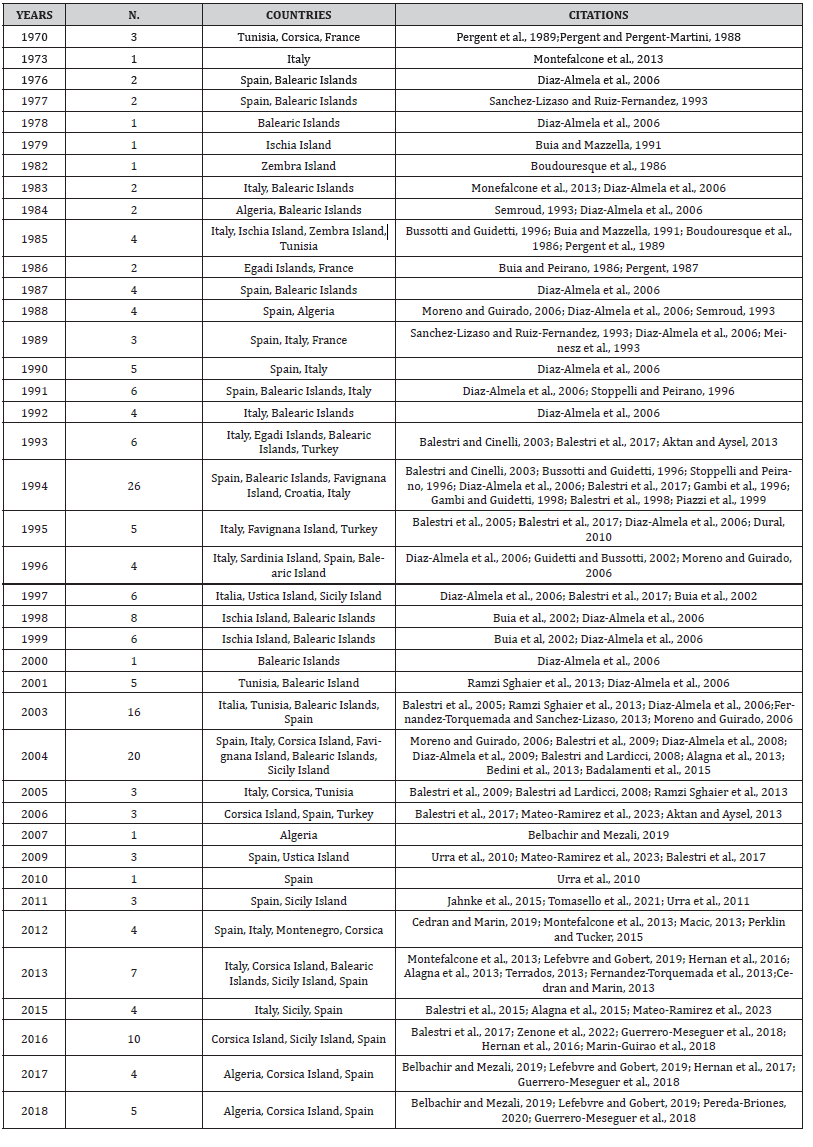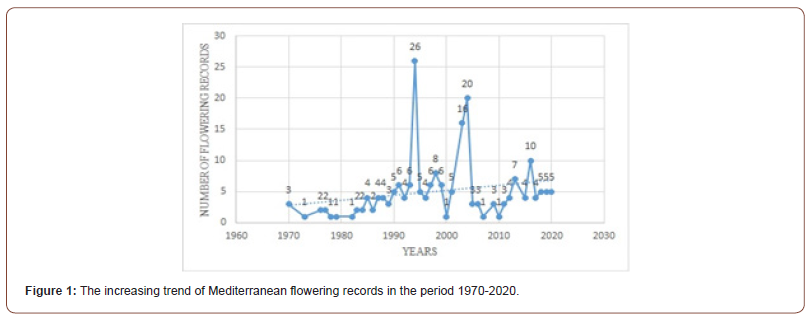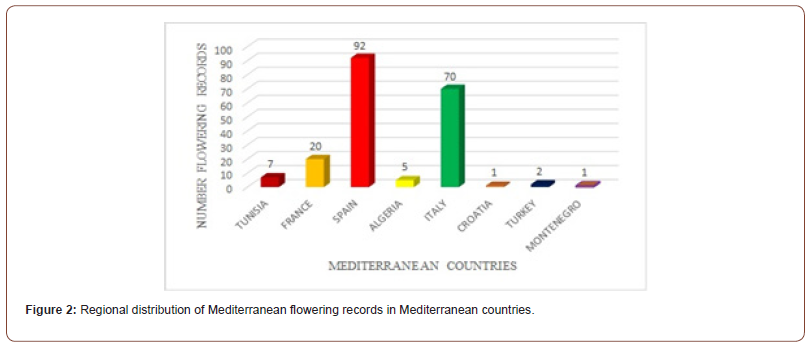 Mini Review Article
Mini Review Article
The Meadows of Posidonia Oceanica (Linnaeus) Delile in a Climate Change Scenario
Nicola Cantasano* Retired
National Research Council, Institute for Agricultural and Forest Systems in the Mediterranean, Rende Research Unit, Italy
Nicola Cantasano, National Research Council, Institute for Agricultural and Forest Systems in the Mediterranean, Rende Research Unit, Italy..
Received Date:March 20, 2023; Published Date:April 20, 2023
Abstract
Posidonia oceanica (Linnaeus) Delile is the most important seagrass species, endemic of Mediterranean Sea [1]. In coastal waters, characterized by good and pristine conditions, the species can form large and extensive meadows on the infalittoral bottoms of the basin [2], according to light conditions. Posidonia beds cover a global surface area valued between 2.5 and 5.0 million hectares [3], being the typical “climax” ecosystem on the mobile substrata of Mediterranean Sea. So, the meadows of Posidonia oceanica have become priority habitat as “Posidonia oceanica” (Habitat Code 1120) within the Habitat Directive (92/43/EC). On the other hand, there is today a fast regression of the Mediterranean praires caused by marine pollution and by increasing human pressures. To counteract such regressive trend Posidonia beds have been inserted as “Best Concern” within the Red List of International Union for Conservation of Nature (IUCN) [4]. Amongst the main threats affecting the fate of Posidonia oceanica meadows it is observed a light but steady increase of Sea Surface Temperature (hereafter SST). This warming trend of seawater temperatures has been detected over the last decade as 0.04 °C yr-1 [5,6]. In particular, the Atmospheric Ocean Regional Climate (AORCM) has predicted a global increase of Mediterranean SST of 2.6 °C in the period 2070-2099 [7]. Generally, this climate change scenario could affect the reproductive phenology of some species of marine plants [8], inducing variations in the distributin and in the abundance of seagrass populations in the short and long run [9]. In this way, such an increase in seawater temperature, within a general trend of marine global warming, could have negative effects on Posidonia oceanica praires, causing their spatial reduction [10]. In fact, it has been recently observed some reduction in the growth of the plant’s vertical rhizomes and a general regression of Posidonia meadows along the Spanish Mediterranean coast, just next some regional seawarming peaks [11,12]. Therefore, it could be hypothesized a close relationship between the declining of Posidonia beds and the warming trend of Mediterranean waters. However, the species is characterized by an effective acclimatization capacity through its high thermotolerance against the increasing overheating of Mediterranean waters [13,14]. As a matter of fact, the reproductive trait of the species, always characterized by asexual reproduction, through rhizome fragmentation and clonal growth, shows in these last decades a gradual shift towards modes of sexual reproduction [15]. This trend is confirmed, also, by the clear increase of flowering events in the Mediterranean Sea, began in the seventies and is actually ongoing. In fact, it is reported a summarizing frame, deduced by scientific literature, of all the flowering records occurred in Mediterranean waters from 1970 to 2020 years (Table 1).
Table 1:Flowering records detected in the coastal waters of Mediterranean countries, in the time lag 1970-2020, drawn by scientific literature (Legend: N.=Number of records).

Introduction
This yearly report shows a total of 198 records in the whole Mediterranean Sea from the Spanish coastline to the Turkish one. Really, most of the records regard the western side of the basin while the reports in the eastern side are quite short, probably for the smaller amount of scientific data available by literature. These flowering events show an increasing trend, year by year, as highlighted by the dotted line of (Figure 1). Indeed, it is possible to observe, by the trend of the continuous line, some recording peaks of flowering records regularly recurring every 10-12 years (Figure1).

The trend of the course, characterized by some regular and spaced peaks, could be induced by conditions of thermal stress because such massive flowering events are closely related to corresponding peaks in seawater temperatures [16,17,18,19]. As regards the regional distribution of flowering records, it is shown a great variability between the Mediterranean countries with Spain, as the first country (92 records), Italy as second (70 records) and France as third (20 records) (Figure 2).
Finally, it is noteworthy to observe that the flowering records reported in these last fifty years are fairly distributed between continental (97 records, as 49%) and island regions (101 records, as 51%) (Figure 3).


Conclusion
Probably, the high number of flowering records, detected in island’s waters, is reported by scientific literature because the recruitment sites of seedlings are very often located in the shallow seawaters of Marine Protected Areas (MPA) along the insulated coasts of Mediterranean Sea as Balearic, Corsica, Sicily, Sardinia and Egadi islands. In last decades it has been noted an increase in flowering records probably related to the gradual rise of SST. So, the increasing temperature of Mediterranean seawaters might support the sexual reproduction of the species [20], as highlighted by the increasing trend of flowering events in these last fifty years. This process could induce a greater genetic diversity in the gene pool of the species improving its high thermotolerance to warming conditions and, more generally, a better adaptive response against the variations of environmental conditions. However, until now, the dynamic of such process is little known, and it remains a debated issue. In this way, it is necessary to analyze in depth the annual variability of Posidonia flowering to better understand the process and its meaning in a climate change scenario. In conclusion, Posidonia oceanica species could be an important and early ecological indicator of the current climate changes induced by the warming trend of Mediterranean seawaters.
Acknowledgement
None.
Conflict of Interest
Author declares no conflict of interest.
References
- Den Hartog C (1970) The seagrasses of the world North Holland Publishing Company, Amsterdam.
- Ghirardelli E (1981) La vita nelle acque Utet Ed Torino Italia pp. 402 (In Italian).
- Pasqualini V, Pergent Martini C, Clabaut P, Pergent G (1998) Mapping of Posidonia oceanica using aerial photographs and side scan sonar. Application off the island of Corsica (France) Estuarine Coastal and Shelf Science 47: 359-367.
- Pergent G, Pergent Martini C, Bein A, Dedeken M, Oberti P, et al. (2015) Dynamic of Posidonia oceanica seagrass meadows in the northwestern Mediterranean: could climate change to be blame? CR Biol 338: 484-493.
- Xoplaki E (2002) Climate variability over the Mediterranean. Switzerland, pp. 211.
- Diaz Almela E, MarbA N, Duarte CM (2007) Consequences of Mediterranean warming events in seagrass (Posidonia oceanica) flowering records. Global Change Biology 13: 224-235.
- Somot S, Sezault F, Deque M, Crepon M (2008) 21st century climate change scenario for the Mediterranean using a coupled atmosphere-ocean regional climate model. Glob Planet Change 63: 112-126.
- Schwartz M (1999) Advances to full bloom: planning phenological research for the 21st century. Int J Biometereol 42: 113-118.
- Hoek WZ (2001) Vegetation response to the ~7 and ~ 11.5 Ka cal. BP climate transitions: is vegetation lagging climate? Global and Planetary Change 30: 103-115.
- Jorda G, Marba N, Duarte CM (2012) Mediterranean seagrass vulnerable to regional climate warming. Nat Clim Change 2: 821-824.
- Marba N, Duarte CM, Cebrian J, Gallegos ME, Olesen B, (1996) Growth and population dynamics of Posidonia oceanica on the Spanish Mediterranean coast: elucidating seagrass decline. Mar Ecol Progr Ser 137: 203-213.
- Marba N, Duarte CM (1998) Rhizome elongation and seagrass clonal growth. Mar Ecol Progr Ser 174: 269-280.
- Marin Guirao L, Ruiz JM, Dattolo E, Garcia Munoz R, Procaccini G (2016) Physiological and Molecular Evidence of Differential Short-Term heat tolerance in Mediterranean Seagrasses. Sci Rep 27; 6: 28615.
- Marin Guirao L, Bernardeau Esteller J, Garcia Munoz R, Ramos A, Ontoria Y, et al. (2018) Carbon Economy of Mediterranean Seagrasses in Response to Thermal Stress. Marine Pollution Bulletin 135: 617-629.
- Martinez Abrain A, Castejon Silvo I, Roiloa S (2022) Foreesing the future of Posidonia oceanica meadows by accounting for the past evolution of the Mediterranean Sea. ICES Journal of Marine Science 79: 2597-2599.
- Giraud G (1977) Contribution a la description et al phenologie quantitative des herbiers de Posidonia oceanica (L.) Delile University of Aix-Marseille, France.
- Mazzella L, Gambi MC, Russo GF, Wittmann JK (1983) Flowering in Posidonia oceanica praires around the island of Ischia (Gulf of Naples). Rapp Comm Int Mer Medit 28: 117-119.
- Boyer M, Bussotti S, Guidetti P, Matricardi G (1996) Notes on the flowering and fruiting of Posidonia oceanica (L.) Delile beds in the Ligurian Sea (North-Western Mediterranean). Boll Mus Ist Biol Univ Genova 60-61: 21-29.
- Diaz Almela E, Marba N, Alvarez E, Balestri E, Ruiz Fernandez JM, (2006) Patterns of seagrass (Posidonia oceanica) flowering in the Western Mediterranean. Mar Biol 148: 723-742.
- Marin Guirao L, Entrambasaguas L, Ruiz JM, Procaccini G (2019) Heat-stress induced flowering can be a potential adaptive response to ocean warming for the iconic seagrass Posidonia oceanica. Molecular Ecology 28(10): 2486-2501.
-
Nicola Cantasano*. The Meadows of Posidonia Oceanica (Linnaeus) Delile in a Climate Change Scenario. Ad Oceanogr & Marine Biol. 3(3): 2023. AOMB.MS.ID.000563.
-
Azolla, Spirulina platensis, GIFT tilapia, Digestive enzymes, Immunity, Carotenoid content, Isocaloric, Anisonitrogenous, Spirulina platensis, Dissolved Oxygen
-

This work is licensed under a Creative Commons Attribution-NonCommercial 4.0 International License.






